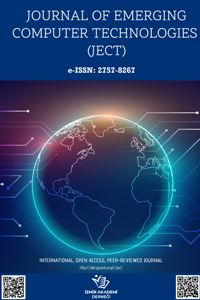Coding Schemes in 5G Networks for Error-free Communication
5G, bit error rate, block error code, channel coding, LDPC code, polar code
Coding Schemes in 5G Networks for Error-free Communication
5G, bit error rate, block error code, channel coding, LDPC code, polar code,
___
- Tsakmalis, A., Chatzinotas, S., and Ottersten, B. (2014). ”Modulation and Coding Classification for Adaptive Power Control in 5G Cognitive Communications. 2014 IEEE 15Th International Workshop On Signal Processing Advances In Wireless Communications (SPAWC).” doi: 10.1109/spawc.2014.6941505
- Abdulwhab, W., and Kadhim, A. (2018). ”Comparative Study of Channel Coding Schemes for 5G. Journal Of Electronic Systems,” 8(3), 95. doi: 10.6025/jes/2018/8/3/95-102
- Iscan, O., Lentner, D., and Xu, W. (2016). ”A Comparison of Channel Coding Schemes for 5G Short Message Transmission. 2016 IEEE Globe-com Workshops (GC Wkshps).” doi: 10.1109/glocomw.2016.7848804
- Kim, H. (2015). ”Coding and modulation techniques for high spectral efficiency transmission in 5G and satcom. 2015 23Rd European Signal Processing Conference (EUSIPCO).” doi: 10.1109/eu-sipco.2015.7362884
- Maunder, R. (2016). ”A Vision for 5G Channel Coding.” Accelercomm White Paper.
- Fadlallah, Y., Tulino, A., Barone, D., Vettigli, G., Llorca, J., and Gorce, J. (2017). ”Coding for Caching in 5G Networks. IEEE Communications Magazine,” 55(2), 106-113. doi: 10.1109/mcom.2017.1600449cm
- Gamage, H., Rajatheva, N., and Latva-aho, M. (2017). ”Channel coding for enhanced mobile broadband communication in 5G systems. 2017 European Conference On Networks And Communications (Eucnc).” doi: 10.1109/eucnc.2017.7980697
- Kaykac Egilmez, Z., Xiang, L., Maunder, R., and Hanzo, L. (2020). ”The Development, Operation and Performance of the 5G Polar Codes. IEEE Communications Surveys & Tutorials”, 22(1), 96-122. doi: 10.1109/comst.2019.2960746
- Ligurgo, M. (2017). ”IoT for 5G: candidate coding schemes.” TORINO: POLITECNICO DI TORINO.
- Do-Duy, T., and Vazquez Castro, M. (2018).” Design of network coding functionality for 5G networks”. Barcelona.
- Sharma, A., and Salim, M. (2018). ”On The Feasibility of Polar Code as Channel Code Candidate for the 5G-IoT Scenarios. International Journal Of Future Generation Communication And Networking ” 11(3), 11-20. doi: 10.14257/ijfgcn.2018.11.3.02
- Vukobratovic, D., Tassi, A., Delic, S., and Khirallah, C. (2018). ”Random Linear Network Coding for 5G Mobile Video Delivery. Information,” 9(4), 72. doi: 10.3390/info9040072
- Arora, K., Singh, J., and Randhawa, Y. (2019). ”A survey on channel coding techniques for 5G wireless networks. Telecommunication Systems,” 73(4), 637-663. doi: 10.1007/s11235-019 00630-3
- Bae, J., Abotabl, A., Lin, H., Song, K., and Lee, J. (2019). ”An overview of channel coding for 5G NR cellular communications. APSIPA Transactions On Signal And Information Processing,” 8. doi: 10.1017/atsip.2019.10
- Mota, M., Araujo, D., Costa Neto, F., de Almeida, A., and Cavalcanti, F. (2019). ”Adaptive Modulation and Coding Based on Reinforcement Learning for 5G Networks. 2019 IEEE Globecom Workshops (GC Wkshps).” doi: 10.1109/gcwkshps45667.2019.9024384
- Pillet, C., Bioglio, V., and Condo, C. (2020). ”On List Decoding of 5G-NR Polar Codes. 2020 IEEE Wireless Communications And Networking Conference (WCNC).” doi: 10.1109/wcnc45663.2020.9120686
- Shah, P., Vyavahare, P., and Jain, A. (2020). ”Performance Evolution of Modern Error Controlling Codes for future generation (5G) cellular systems: LDPC code.” doi: 10.21203/rs.3.rs-22526/v1
- Yayın Aralığı: Yıllık
- Başlangıç: 2021
- Yayıncı: İzmir Akademi Derneği
A Dynamic Method and Program for Multiple Password Generation and Management
Onur ÇAKIRGÖZ, Süleyman SEVİNÇ
Practical Evaluation on Serious Games in Education
Slavica Mileva EFTİMOVA, Ana Madevska BOGDANOVA, Vladimir TRAJKOVİK
Overview of Techniques and Methods for Stress Recognition
Automatic Movie Rating by Using Twitter Sentiment Analysis and Monitoring Tool
Coding Schemes in 5G Networks for Error-free Communication
Oliver SİMONOSKİ, Ninoslav MARİNA, Natasa DİMOSKA
Development of An Efficient Tool to Convert Regular Expressions to NFA
GoHammer Blockchain Performance Test Tool
Melih BİRİM, Hüseyin Emre ARI, Enis KARAARSLAN
Coding Schemes for DNA Patient Record Processing to Electronic Health Records Systems
Izabela MİTRESKA, Ninoslav MARİNA, Natasa DİMOSKA
Digital Twin Based Disaster Management System Proposal: DT-DMS
Özgür DOĞAN, Oğuzhan ŞAHİN, Enis KARAARSLAN
